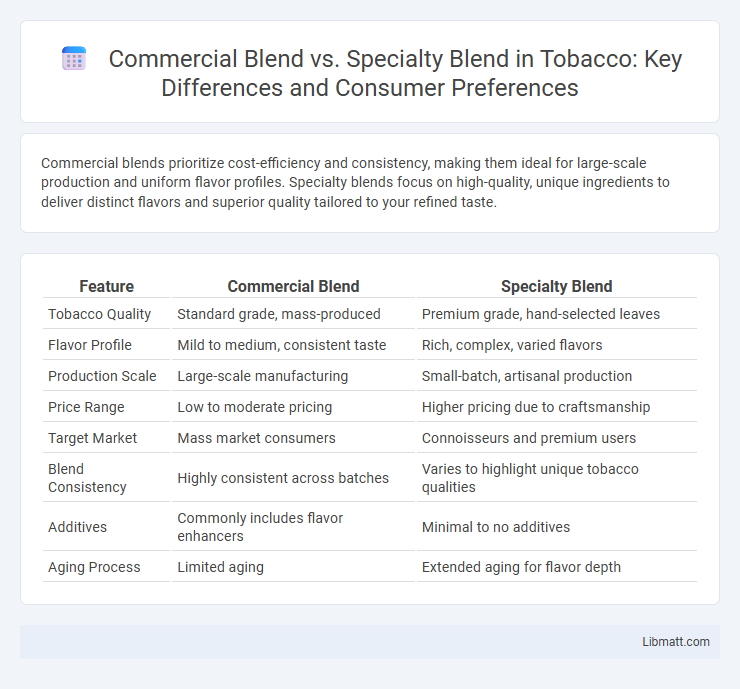Commercial blends prioritize cost-efficiency and consistency, making them ideal for large-scale production and uniform flavor profiles. Specialty blends focus on high-quality, unique ingredients to deliver distinct flavors and superior quality tailored to your refined taste.
Table of Comparison
| Feature | Commercial Blend | Specialty Blend |
|---|---|---|
| Tobacco Quality | Standard grade, mass-produced | Premium grade, hand-selected leaves |
| Flavor Profile | Mild to medium, consistent taste | Rich, complex, varied flavors |
| Production Scale | Large-scale manufacturing | Small-batch, artisanal production |
| Price Range | Low to moderate pricing | Higher pricing due to craftsmanship |
| Target Market | Mass market consumers | Connoisseurs and premium users |
| Blend Consistency | Highly consistent across batches | Varies to highlight unique tobacco qualities |
| Additives | Commonly includes flavor enhancers | Minimal to no additives |
| Aging Process | Limited aging | Extended aging for flavor depth |
Understanding Coffee Blends: Commercial vs. Specialty
Commercial coffee blends are typically designed for mass appeal and consistent flavor, using lower-cost beans from multiple origins to ensure affordability and availability. Specialty blends prioritize unique flavor profiles and quality, often combining high-grade Arabica beans with precise roasting techniques to highlight origin characteristics. Understanding these differences helps you make informed choices based on your taste preferences and budget.
Defining Commercial Blend Coffee
Commercial blend coffee refers to a mass-produced mixture of coffee beans designed for broad consumer appeal and consistent flavor profiles. These blends typically use lower-cost Arabica and Robusta beans, emphasizing affordability and volume over unique origin characteristics. Commercial blends prioritize uniform taste and aroma to suit a wide range of palates and brewing methods in cafes and retail markets.
What Makes a Coffee Specialty Blend?
A specialty blend coffee is defined by its high-quality beans sourced from specific regions known for unique flavor profiles, often rated above 80 points on the Specialty Coffee Association scale. These blends emphasize traceability, single-origin characteristics, and expert roasting techniques that highlight distinct nuances and complex aromas. In contrast, commercial blends prioritize consistency and cost-efficiency, generally using lower-grade beans with less focus on individual flavor complexity.
Sourcing and Quality: A Key Difference
Commercial blends typically source beans from multiple regions to ensure consistent flavor and cost-efficiency, often prioritizing volume over uniqueness. Specialty blends emphasize high-quality, single-origin or limited-origin beans, carefully selected to highlight distinct flavor profiles and superior freshness. This targeted sourcing results in higher cup quality and a more refined taste experience compared to standard commercial blends.
Flavor Profiles: Comparing Commercial and Specialty Blends
Commercial blends typically feature consistent, mild flavor profiles designed for mass appeal, often emphasizing balanced bitterness and low acidity to suit a wide range of consumers. Specialty blends prioritize complex, nuanced flavor notes such as fruity, floral, or chocolate undertones, highlighting high-quality beans sourced from specific regions or microlots. The distinct flavor profiles of specialty blends aim to deliver a unique sensory experience, contrasting with the more standardized and uniform taste of commercial blends.
Roasting Techniques for Commercial and Specialty Blends
Commercial blends use high-temperature, fast roasting techniques to achieve consistent flavor profiles and maximize production efficiency, often resulting in a uniform, darker roast. Specialty blends rely on slower, precision roasting at variable temperatures, allowing for the development of complex aromas and preserving unique bean origins. Roasting equipment like drum roasters or air roasters is selected based on blend type, with specialty blends benefiting from greater control over variables such as time, temperature, and airflow to highlight nuanced flavor notes.
Price Point: Affordability vs. Premium Experience
Commercial blends typically offer a lower price point, making them an affordable choice for bulk purchasing and everyday use. Specialty blends command a premium price due to their unique flavor profiles, high-quality sourcing, and limited availability, providing a distinctive experience for discerning consumers. Your selection depends on whether affordability or an exclusive, nuanced taste is your priority.
Environmental and Ethical Considerations
Commercial blends often prioritize cost-efficiency, which can lead to sourcing from suppliers with less stringent environmental and ethical standards, resulting in higher carbon footprints and potential labor concerns. Specialty blends emphasize sustainable farming practices, fair trade certifications, and traceability, ensuring that Your coffee consumption supports eco-friendly methods and ethical labor conditions. Choosing specialty blends promotes biodiversity, reduces environmental impact, and empowers farming communities through fair compensation.
Consumer Preferences and Market Trends
Consumer preferences reveal a growing demand for specialty blends due to their unique flavor profiles and perceived higher quality compared to commercial blends, which tend to prioritize consistency and affordability. Market trends indicate an increasing shift towards specialty blends as consumers seek artisanal and ethically sourced coffee, driving premium pricing and niche market growth. Data from recent industry reports show specialty blends capturing a larger market share, reflecting evolving tastes and a willingness to pay more for differentiated coffee experiences.
Choosing the Right Blend for Your Needs
Choosing the right blend for your needs depends on the desired flavor profile and quality experience you seek. Commercial blends typically use a mix of various coffee beans to achieve a consistent, moderately priced product, while specialty blends prioritize unique origin beans and roasting techniques for distinct, premium flavors. Your choice should align with whether you value affordability and uniform taste or exceptional quality with complex characteristics.
commercial blend vs specialty blend Infographic

 libmatt.com
libmatt.com